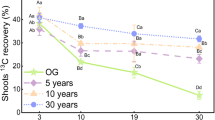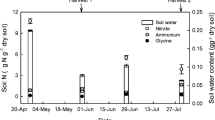Abstract
In grasslands, sustained nitrogen loading would increase the proportion of assimilated carbon allocated to shoot growth (A shoot), because it would decrease allocation to roots and also encourage the contribution of species with inherently high A shoot. However, in situ measurements of carbon allocation are scarce. Therefore, it is unclear to what extent species that coexist in grasslands actually differ in their allocation strategy or in their response to nitrogen. We used a mobile facility to perform steady-state 13C-labeling of field stands to quantify, in winter and autumn, the daily relative photosynthesis rate (RPR~tracer assimilated over one light-period) and A shoot (~tracer remaining in shoots after a 100 degree days chase period) in four individual species with contrasting morpho-physiological characteristics coexisting in a temperate grassland of Argentina, either fertilized or not with nitrogen, and either cut intermittently or grazed continuously. Plasticity in response to nitrogen was substantial in most species, as indicated by positive correlations between A shoot and shoot nitrogen concentration. There was a notable interspecific difference: productive species with higher RPR, enhanced by fertilization and characterized by faster leaf turnover rate, allocated ~20 % less of the assimilated carbon to shoot growth than species of lower productivity (and quality) characterized by longer leaf life spans and phyllochrons. These results imply that, opposite to the expected response, sustained nitrogen loading would change little the A shoot of grassland communities if increases at the species-level are offset by decreases associated with replacement of ‘low RPR-high A shoot’ species by ‘high RPR-low A shoot’ species.




Similar content being viewed by others

References
Aerts R (1999) Interspecific competition in natural plant communities: mechanisms, trade-offs and plant-soil feed-backs. J Exp Bot 50:29–37. doi:10.1093/jxb/50.330.29
Aerts R, Boot R, van der Aart P (1991) The relation between above- and belowground biomass allocation patterns and competitive ability. Oecologia 87:551–559. doi:10.1007/BF00320419
Amthor JS (2000) The McCree—deWit—Penning de Vries—Thornley respiration paradigms: 30 years later. Ann Bot 86:1–20. doi:10.1006/anbo.2000.1175
Anten NPR (2005) Optimal photosynthetic characteristics of individual plants in vegetation stands and implications for species coexistence. Ann Bot 95:495–506. doi:10.1093/aob/mci048
Bahn M, Lattanzi FA, Hasibeder R, Wild B, Koranda M, Danese V, Brüggeman N, Schmitt M, Siegwolf R, Richter A (2013) Responses of belowground carbon allocation dynamics to extended shading in mountain grassland. New Phytol 198:116–126. doi:10.1111/nph.12138
Barkworth ME (1990) Nassella (Gramineae, Stipeae): revised interpretation and nomenclatural changes. Taxon 39:597–614. doi:10.2307/1223366
Bélanger G, Gastal F, Warembourg FR (1992) The effects of nitrogen fertilization and the growing season on carbon partitioning in a sward of tall fescue (Festuca arundinacea Schreb). Ann Bot 70:239–244
Bélanger G, Gastal F, Warembourg FR (1994) Carbon balance of tall fescue (Festuca arundinacea Schreb.): effects of nitrogen fertilization and the growing season. Ann Bot 74:653–659. doi:10.1006/anbo.1994.1167
Berenson ML, Levine DM, Goldztein M (1983) Intermediate statistical methods and applications. Prentice-Hall, New York
Berone GD (2012) The role of photosynthetic capacity and of leaf area ratio for the carbon gain of C3 and C4 species during the cool season in the Río de la Plata grasslands. PhD dissertation, Technische Universität München, Germany
Burkart SE, León RJC, Perelman S, Agnusdei MG (1998) The grasslands of the Flooding Pampa (Argentina): floristic heterogeneity of the natural communities of the southern Río Salado Basin. Coenoses 13:1–27
Craine JM (2005) Reconciling plant strategy theories of Grime and Tilman. J Ecol 93:1041–1052. doi:10.1111/j.1365-2745.2005.01043.x
Craine JM, Tilman D, Wedin DA, Reich P, Tjoelker M, Knops J (2002) Functional traits, productivity and effects on nitrogen cycling of 33 grassland species. Funct Ecol 16:563–574. doi:10.1046/j.1365-2435.2002.00660.x
Epron D, Bahn M, Derrien D, Lattanzi FA, Pumpanen J, Gessler A, Högberd P, Maillard P, Dannoura M, Gérant D, Buchmann N (2012) Pulse-labelling trees to study carbon allocation dynamics: a review of methods, current knowledge and future prospects. Tree Physiol 32:776–798. doi:10.1093/treephys/tps057
Farrar JF (1989) The carbon balance of fast-growing and slow-growing species. In: Lambers H, Cambridge ML, Konings H, Pons TL (eds) Causes and consequences of variation in growth rate and productivity of higher plants. SPB, The Hague, pp 241–256
Farrar JF, Gunn S (1998) Allocation: allometry, acclimation-and alchemy? In: Lambers H, Poorter H, Van Vuuren MMI (eds) Inherent variation in plant growth. Physiological mechanisms and ecological consequences. Backhuys, Leiden, pp 183–198
Gamnitzer U, Schäufele R, Schnyder H (2009) Observing 13C labelling kinetics in CO2 respired by a temperate grassland ecosystem. New Phytol 184:376–386. doi:10.1111/j.1469-8137.2009.02963.x
Grimoldi AA, Kavanová M, Lattanzi FA, Schnyder H (2005) Phosphorus nutrition mediated effects of Arbuscular mycorrhiza on leaf morphology and carbon allocation in perennial ryegrass. New Phytol 168:435–444. doi:10.1111/j.1469-8137.2005.01500.x
Hikosaka K, Sudoh S, Hirose T (1999) Light acquisition and use by individuals competing in a dense stand of an annual herb, Xanthium canadense. Oecologia 118:388–396
Hill PW, Marshall C, Williams GG, Harmens H, Jones DL, Farrar JF (2007) The fate of photosynthetically-fixed carbon in Lolium perenne grassland as modified by elevated CO2 and sward management. New Phytol 173:766–777. doi:10.1111/j.1469-8137.2006.01966.x
Lattanzi FA, Schnyder H, Thornton B (2004) Defoliation effects on carbon and nitrogen substrate import and tissue-bound efflux in leaf growth zones of grasses. Plant Cell Environ 27:347–356. doi:10.1046/j.1365-3040.2004.01147.x
Lattanzi FA, Berone GD, Feneis W, Schnyder H (2012) 13C-labeling shows the effect of hierarchy on the carbon gain of individuals and functional groups in dense field stands. Ecology 93:169–179. doi:10.1890/11-1166.1
Lehmeier CA, Lattanzi FA, Schaeufele R, Schnyder H (2010) Nitrogen deficiency increases the residence time of respiratory carbon in the respiratory substrate supply system of perennial ryegrass. Plant Cell Environ 33:76–87. doi:10.1111/j.1365-3040.2009.02058.x
Lemaire G, Agnusdei MG (2000) Leaf tissue turnover and efficiency of herbage utilization. In: Lemaire G, Hodgson J, de Moraes A, Nabinger C, de Carvalho PC (eds) Grassland ecophysiology and grazing ecology. CAB International, Wallingford, pp 265–287
Milchunas D (2009) Estimating root production: comparison of 11 methods in shortgrass steppe and review of biases. Ecosystems 12:1381–1402. doi:10.1007/s10021-009-9295-8
ModelMaker (2000) ModelMaker user manual. Cherwell Scientific Limited, Oxford
Motulsky HJ, Christopoulos A (2003) Fitting models to biological data using linear and non linear regression. A practical guide to curve fitting. GraphPad Software, San Diego
Ong CK, Marshall C (1979) The growth and survival of severely-shaded tillers in Lolium perenne L. Ann Bot 43:147–155
Perelman SB, León RJC, Oesterheld M (2001) Cross-scale vegetation patterns of Flooding Pampa grasslands. J Ecol 89:562–577. doi:10.1046/j.0022-0477.2001.00579.x
Poorter H, Pothmann P (1992) Growth and carbon economy of a fast-growing and a slow-growing grass species as dependent on ontogeny. New Phytol 120:159–166. doi:10.1111/j.1469-8137.1992.tb01069.x
Poorter H, Remkes C, Lambers H (1990) Carbon and nitrogen economy of 24 wild species differing in relative growth rate. Plant Physiol 94:621–627. doi:10.1104/pp.94.2.621
Poorter H, Niklas KJ, Reich PB, Oleksyn J, Poot P, Mommer L (2012) Biomass allocation to leaves, stems and roots: meta-analyses of interspecific variation and environmental control. New Phytol 193:30–50. doi:10.1111/j.1469-8137.2011.03952.x
Puget P, Drinkwater LE (2001) Short-term dynamics of root- and shoot-derived carbon from a leguminous green manure. Soil Sci Soc Am J 65:771–779. doi:10.2136/sssaj2001.653771x
Reich PB (2002) Root-shoot relations: optimality in acclimation and adaption or the “Emperor’s new clothes”? In: Waisel Y, Eshel A, Kafkafi U (eds) Plant roots: the hidden half, vol 3rd. Marcel Dekker, New York, pp 205–220
Robson MJ, Deacon MJ (1978) Nitrogen deficiency in small closed communities of S24 ryegrass. 2. Changes in the weight and chemical composition of single leaves during their growth and death. Ann Bot 42:1199–1213
Rodríguez Palma R, Rodríguez T, Errandonea M, Kuchman C, Periano E, Pirez V, Rodríguez D (2010) Morfogénesis y estructura de dos gramíneas invernales nativas bajo pastoreo. Rev Argent Prod Anim 30:429–430
Rosengurtt B (1979) Tablas de comportamiento de las especies de plantas de campos naturales en el Uruguay. Departamento de Publicaciones y Ediciones de la Universidad de la República, Montevideo
Saggar S, Hedley C, Mackay AD (1997) Partitioning and translocation of photosynthetically fixed 14C in grazed hill pastures. Biol Fert Soils 25:152–158. doi:10.1007/s003740050296
Schleip I (2012) Carbon residence time in above-ground and below-ground biomass of a grazed grassland community. PhD dissertation, Technische Universität München, Germany
Schleip I, Lattanzi FA, Schnyder H (2013) Common leaf life span of co-dominant species in a continuously grazed temperate pasture. Basic Appl Ecol 14:54–63. doi:10.1016/j.baae.2012.11.004
Schnyder H (1992) Long-term steady-state labelling of wheat plants by use of natural 13CO2/12CO2 mixtures in an open, rapidly turned-over system. Planta 187:128–135. doi:10.1007/BF00201634
Schnyder H, de Visser R (1999) Fluxes of reserve-derived and currently assimilated carbon and nitrogen in perennial ryegrass recovering from defoliation. The regrowing tiller and its components functionally distinct zones. Plant Physiol 119:1423–1435. doi:10.1104/pp.119.4.1423
Schnyder H, Lattanzi FA (2005) Partitioning respiration of C3–C4 mixed communities using the natural abundance 13C approach—testing assumptions in a controlled environment. Plant Biol 7:592–600. doi:10.1055/s-2005-872872
Subke JA, Heinemeyer A, Vallack HW, Leronni V, Baxter R, Ineson P (2012) Fast assimilate turnover revealed by in situ CO2-C-13 pulse-labelling in subarctic tundra. Polar Biol 35:1209–1219. doi:10.1007/s00300-012-1167-6
Swinnen J, Van Veen JA, Merckx R (1994) 14C pulse-labelling of field-grown spring wheat: an evaluation of its use in rhizosphere carbon budget estimations. Soil Biol Biochem 26:161–170. doi:10.1016/0038-0717(94)90159-7
Thornley JHM (1998) Modelling shoot: root relations: the only way forward? Ann Bot 81:165–171. doi:10.1006/anbo.1997.0529
Warembourg FR, Paul EA (1973) The use of C14O2 canopy techniques for measuring carbon transfer through the plant-soil system. Plant Soil 38:331–345. doi:10.1007/BF00779017
Weiner J (2004) Allocation, plasticity and allometry in plants. Perspect Plant Ecol 6:207–215. doi:10.1078/1433-8319-00083
Welker JM, Rykiel EJ, Briske DD, Goeschl JD (1985) Carbon import among vegetative tillers within two bunchgrasses: assessment with carbon-11 labelling. Oecologia 67:209–212. doi:10.1007/BF00384285
Wilson JB (1988) A review of evidence on the control of shoot: root ratio, in relation to models. Ann Bot 61:433–449
Woodin SJ, van der Wal R, Sommerkorn M, Gornall JL (2009) Differential allocation of carbon in mosses and grasses governs ecosystem sequestration: a 13C tracer study in the high Arctic. New Phytol 184:944–949. doi:10.1111/j.1469-8137.2009.03022.x
Wu Y, Tan H, Deng Y, Wu J, Xu X, Wang Y, Tang Y, Hiashi T, Cui X (2010) Partitioning pattern of carbon flux in a Kobresia grassland on the Qinghai–Tibetan Plateau revealed by field 13C pulse-labeling. Glob Change Biol 16:2322–2333. doi:10.1111/j.1365-2486.2009.02069.x
Yang JZ, Matthew C, Rowland RE (1998) Tiller axis observations for perennial ryegrass (Lolium perenne) and tall fescue (Festuca arundinacea): number of active phytomers, probability of tiller appearance, and frequency of root appearance per phytomer for three cutting heights. NZ J Agric Res 41:11–17
Acknowledgments
We thank Ing. Agr. E. Obregón and all the staff at the “Colonia Ortiz Basualdo” for providing local support, the research site, cattle, and invaluable help. This work was funded by the Deutsche Forschungsgemeinschaft and the Bundesministerium für wirtschafliche Zusammenarbeit und Entwicklung (Germany) through the “DFG/BMZ programme for collaboration with developing countries” (LA2390/1-1), and by the Instituto Nacional de Tecnología Agropecuaria (INTA, Argentina), through the national project AEFP2492.
Conflict of interest
The authors declare that they have no conflict of interest.
Author information
Authors and Affiliations
Corresponding author
Additional information
Communicated by Fernando Valladares.
Electronic supplementary material
Below is the link to the electronic supplementary material.
Rights and permissions
About this article
Cite this article
Gong, X.Y., Berone, G.D., Agnusdei, M.G. et al. The allocation of assimilated carbon to shoot growth: in situ assessment in natural grasslands reveals nitrogen effects and interspecific differences. Oecologia 174, 1085–1095 (2014). https://doi.org/10.1007/s00442-013-2838-x
Received:
Accepted:
Published:
Issue Date:
DOI: https://doi.org/10.1007/s00442-013-2838-x



